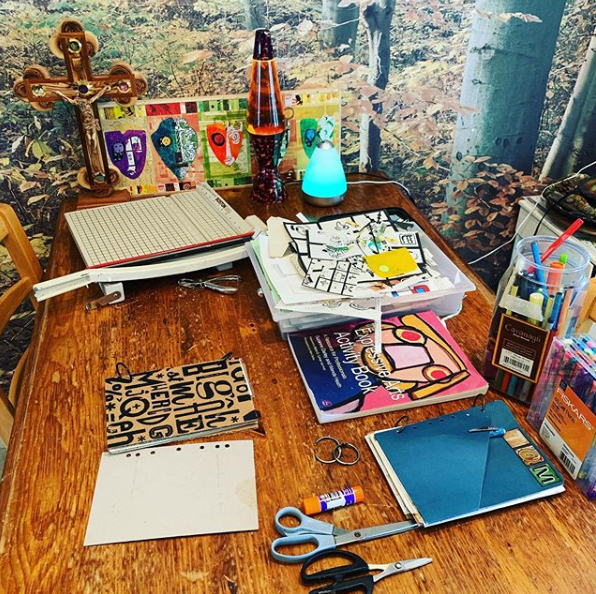And Happy Holidays to all!
This year I made two Christmas card designs. This first version started out as a mixed media art journal page. I scanned it and used Photoshop to add background shapes, manipulate colors and to add details. I started it two years ago, and got it out again last year, but I just didn’t get it to where I wanted it until the third try. I added in some of the faux postage designs Tom and I made a few weeks ago and that was finally the finishing touch it needed!

As often happens, while scanning in and manipulating the faux postage designs to use as accents, I got another idea and was in the mood for some brighter colors so I made another card design. I had both cards printed and sent one design to half the Christmas card list and the other to the remainder.

Besides the digital manipulation, the art and craft media and techniques that went into this card design consist of the following: rubber stamps, hole punches, collage, stickers, design tape (washi tape), and image transfers.

The picture on the left shows how a lot of our Christmas cards went out. We each made two sheets of faux postage. Tom didn’t care about having color copies made of his or displaying them as full sheets, so I scanned his two faux postage sheets to make black and white versions for coloring. Last year we were able to invite family members to help color in and draw on paper items for Tom’s beard in person but this year we are not doing gatherings in person so we are encouraging people to mail things in for Tom’s beard. We made the black and white shaped tags to give people something to color on in case they are stuck for an idea.
For those who got a little envelope of paper bits, those are for designing and collaging with if you choose, or you can just enjoy them in different paper projects if you have any. I made a Pinterest board on which I collect ideas for things to make with scraps. Scraps and paper ephemera are endlessly inspiring to me.
https://www.pinterest.com/tdannenf/made-from-scraps/
Tom is a good sport and is having fun thinking of places to take the photos each day and also helping pick out filters. I downloaded a couple of new phone apps that have some crazy filters in them and I’m enjoying using them to help make an art statement.
Here are the results for Day 1. I added a hint of a grunge frame, the hashtag in text and a border in Photoshop after sharing it on a couple of social media sites first. As I get used to how the sharing process works with the new filter apps I’m trying out, this part should run more smoothly.

#12dayoftomsbeard lasts until January 6, so there is still plenty of time if you want to send something in! Some people probably don’t even have their greeting cards yet since I was a bit late getting them out due to school. I’m used to having to throw together holiday themed promotions at the last minute because often when working for a company or clients we would not have much time available to plan so we’d have to wait until client work slowed down right before Christmas to even start. It was and is frustrating to have to hurry through the planning and execution because we could have been so much more effective with more strategy and care. It was good practice for doing things fast though – I had to work fast once again this year because I’m in graduate school and there is very little time between the end of class and Christmas to work with. I don’t have much time to make gifts so a little fun activity and putting some extra work into the cards is the best I can do. I’m having fun with it – I hope other people do too!























